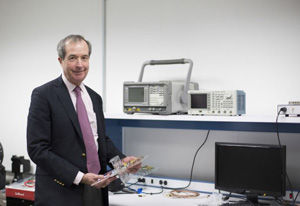The Institute of Electrical and Electronics Engineers (IEEE) will award the 2017 Communications Society Industrial Innovation Award to Thomas L. Marzetta for “originating the concept of Massive MIMO, and for sustained contributions to the development and promotion of that technology.” Massive MIMO (Multiple-Input Multiple-Output) is considered a key enabler for the fifth generation of wireless technology, or 5G.
Massive MIMO utilizes numerous small, individually controlled, low-power antennas to direct streams of information, selectively and simultaneously, to many users. This confers spectral efficiency orders of magnitude greater than that experienced in 4G service, along with high-quality service throughout the cell, simplicity and scalability, and outstanding energy efficiency.
Such improvements in speed, system throughput, and capacity are critical: Mobile traffic has grown 18-fold over the past five years; in 2021 it will be seven times higher than it was in 2016, video will account for more than 78 percent of all mobile data, and smart terminals will consume an average of 15 GB of data per month.
Marzetta, who in September 2017 joined NYU Tandon as a Distinguished Industry Professor and member of the faculty of NYU WIRELESS, a multi-school research center, will receive the award on December 5, 2017, in conjunction with IEEE GLOBECOM, a flagship conference of the IEEE Communications Society (ComSoc) and the world’s largest annual gathering of communications engineering professionals from academia, industry, and government.
Marzetta developed the concept of Massive MIMO during his 22 years at Bell Labs, where he directed the Communications and Statistical Sciences Department within the former Mathematical Sciences Research Center. In 2014 he was elected a Bell Labs Fellow.
Marzetta’s seminal paper on Massive MIMO, Noncooperative cellular wireless with unlimited numbers of base station antennas, published in 2010 in IEEE Transactions on Wireless Communications, has been cited nearly 3,000 times. He is the author or co-author of more than 220 published papers and is the lead author of the book Fundamentals of Massive MIMO, published last year.
A fellow of the IEEE, Marzetta has received many other honors from the Institute. In 2013 he garnered the IEEE Guglielmo Marconi Prize Paper Award. In 2015 he won both the IEEE Stephen O. Rice Prize and the IEEE W. R. G. Baker Award. The article Five disruptive technology directions for 5G, which he co-authored, also won the 2016 IEEE Fred W. Ellersick Prize, given annually for the best article published in a IEEE Communications Society Magazine in the previous three calendar years.
After graduating with a doctorate in electrical engineering from the Massachusetts Institute of Technology in 1978, Marzetta began work in the field of petroleum exploration at Schlumberger-Doll Research. In 1995 he moved to the defense industry, spending eight years at Nichols Research Corporation to work on radar signal processing and video motion detection.
“It’s a great honor to receive the IEEE Communications Society Industrial Innovation Award,” Marzetta said. “Credit is also due to my many academic and industrial collaborators, without whom Massive MIMO would never have impacted the wireless industry as it has. I am hugely grateful for the support that I received over the years from Bell Labs; there is no other industrial lab where I would have had the freedom to follow the research paths that I took.”
As a faculty member of NYU WIRELESS, a multidisciplinary research center founded in 2012 to develop the fundamental theories and techniques for next-generation mass-deployable wireless devices, Marzetta is focusing on the sixth generation of wireless technology. Within a research initiative that he calls “Beyond Massive MIMO”, he is investigating entirely new principles of operation which could result in wireless systems performing at a level orders-of-magnitude above that of Massive MIMO.
“Thomas Marzetta’s revolutionary work on antenna arrays began as an academic idea, but is now one of the hottest topics in wireless and promises to be a cornerstone of next-generation mobile technology for information and entertainment, healthcare, smart homes and cities, manufacturing, transportation and more,” said NYU Tandon Dean Katepalli R. Sreenivasan. “His research and mentorship here at NYU Tandon will inspire a new generation of engineers who will make the promise of 5G wireless and beyond a reality. His active involvement in the IEEE proves his devotion to the scientific community, and his tireless work to ensure the widespread availability of wireless service proves his commitment to placing technology in service to society. Those are the ideals that we hold in high esteem here at NYU Tandon.”

